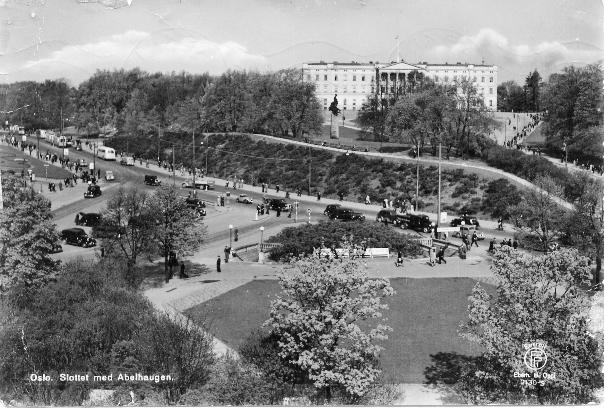Oslo Royal Palace Traditional Geocache
-
Difficulty:
-

-
Terrain:
-

Size:  (micro)
(micro)
Please note Use of geocaching.com services is subject to the terms and conditions
in our disclaimer.
Small container with logbook & pencil. Room for a few
geocoins. Stealth - the place may be crowded at times.
Lten boks med loggbok og blyant. Plass til geomynter. Vær varsom -
stedet kan være folksomt til tider.
The Royal Palace
The royal palace is the permanent residence for the royal couple in
Norway - king Harald V and queen Sonja. The construction of the
palace started in 1825 during the reign of Karl III Johan (for
which the main street in Oslo is named), but the building was not
completed until 1849 when Oscar I was on the throne. During the
union between Norway and Sweden (1814 - 1905) the palace was only
used when members of the royal family, living in stockholm, visited
the city.

Oslo Royal palace, 1948.
The palace was drawn by the danish-born architect Lindstow, and
changed several times during the construction period. Presently, it
contains 173 rooms, including a private part where the royal couple
lives, and several official rooms used by the royal family for
offical business like receptions and audiences by foreign officials
or ordinary citizens granted a meeting with the head of state. The
palace is also used for official dinners and festives. For tourists
visiting Oslo, there is the possibilty of a guided tour of the some
of the official parts of the palace. More information can be found
at the web pages of the royal palace and the royal family
(www.kongehuset.no)
Every year since 1906 (except for 1910 when queen Mauds father,
king Edward VII of England died, and 1940-1945 when members of the
royal family was living in England and USA) the national day of
Norway (May 17th) has been celebrated by a childrens parade walking
up the Karl Johan street to the palace and across the royal palace
square to greet the royal family. Thousands of children from the
primary schools accross the city participate in the parade.

Childrens parade on the national day, May 17th.
Kings of the union between Norway and Sweden related to the royal
palace:
- Karl III Johan (king 1818 - 1844; known as Carl XIV Johan in
Sweden)
- Oscar I (king 1844 - 1859)
- Karl IV (king 1859 - 1872; known as Carl XV in Sweden)
- Oscar II (king 1859 - 1905 in Norway, until 1907 in
Sweden)
Kings and queens of the independet kingdom of Norway - living
permanently at the royal palace, except for the period 1940 -
1945:
- Haakon VII (king 1905 - 1957; elected king of Norway in a
referendum in 1905; before that he was prince Carl of Denmark)
& Maud (queen 1905 - 1938; first queen in Norway since
1319)
- Olav V (king 1957 - 1991; born in Sandringham, England and
named Alexander Edward Christian Frederik, changed to Olav when his
father became king Haakon VII in 1905). His wife, crown princess
Märtha, died in 1954 before Olav became king of Norway.
- Harald V (present king of Norway since 1991) & queen
Sonja.
Very short timeline history of Norway
- 800 - 900: Slowly gathered as a united kingdom under one king,
Harald Hårfagre (king Harald I, ca 872 - 933). The viking
period.
- 1000 - 1100: Christianity imposed by several kings (Olav
Tryggvason, 995 - 1000 and Olav den hellige, 1015 - 1030). Capital
between 1030 and 1217 is Trondheim.
- 1130 - 1240: Civil wars, ended with a strong kingdom under King
Magnus Lagabøte (He who makes the laws). Norway now includes the
"western islands" Iceland, Greenland, Feroe Islands, Isle of Man,
Orkney, Hebrides and Shetland. Capitals are Bergen (1217 -
1314) and later Oslo (1314 until present).
- 1349/50: The black death - 50% population decrease.
- 1397: Norway joins the Kalmar union together with Denmark and
Sweden.
- 1450: Norway and Denmark forms a union with a common royal
family (in Copehagen). The union with Denmark (434 years in total)
is sometimes called "The long night" since Norway was the weaker
part in the union. All official business took place in Copenhagen.
Danish was the official language and officials were pointed out by
the administration in Copenhagen.
- 1814: Denmark supported Napoleon during his campaigns, and
since Napoleon lost at Waterloo in 1814, Norway is handed over to
the king of Sweden in 1814 as part of the Kiel peace treaty after
the Napoleon wars. Denmark keeps control over the larger western
islands (Iceland, Greenland, Feroe islands).
- 1814: Norway get its own consitution, signed May 16th.
Christiania (now Oslo) becomes capital of Norway. Norway also gets
an independent parliament (Stortinget), army, naval fleet, central
bank and currency.
- 1905: The union between Norway and Sweden is ended by a
referendum in Norway - and without military intevention. The
Norwegian parliament calls for another referendum where monarchy is
preferred over republic. Prins Carl of Denmark is crowned as king
Haakon VII of Norway.
Very short timeline history of Oslo
- Founded ca. 1000 AD
- Capital from 1314 (king Håkon V)
- Akershus Fortress and castle erected ca. 1300
- Large fire in 1624. The new city build close to Akershus castle
and fortress. City named Christiania after the danish king
Christian IV.
- Provincial administrative centre in the Denmark-Norway union
until 1814
- 1850: Largest city in Norway
- 1878: Renamed to Kristiania
- 1925: Renamed to Oslo

The nice pond in the Royal Palace garden.
Additional Hints
(Decrypt)
[Eng] Fvg qbja pybfr gb yvtug cbyr - ybt va crnpr
[Nor] Frgg qrt arq irq fvqra ni ynzcra - ybtt v serq bt eb